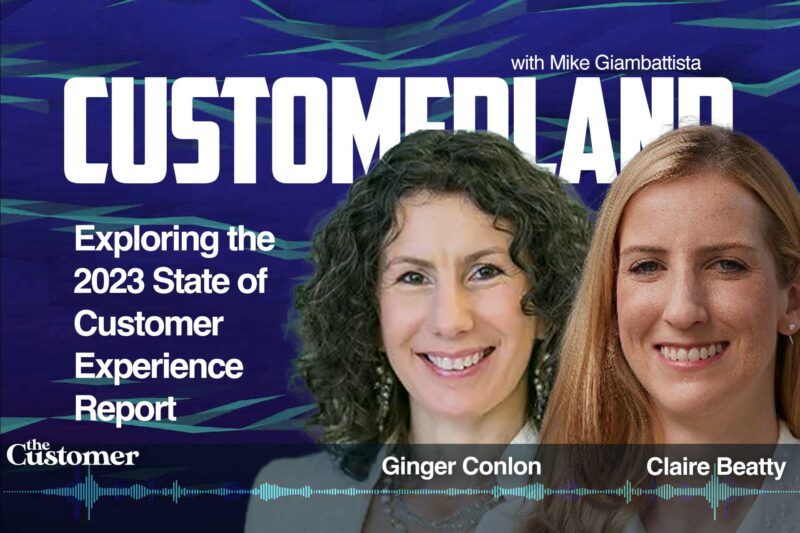Insights on Loyalty, Expectations, and the People Paradox
What if you could understand the key to customer loyalty, employee retention, and an impressive customer experience? We unearth these insights with Ginger Conlon and Claire Beatty from Genesys in our enlightening conversation about the 2023 State of CX Report.
Our journey navigates through the current landscape of customer experience, exploring the intriguing statistic that only 43% of customers feel highly valued post-interaction, leading us to question the role of relevance in this sphere. We dissect what constitutes a poor customer experience, and the alarming speed at which customers switch businesses after a negative encounter. The chat takes a turn into the digital world as we scrutinize the current state of digital transformation, with companies transitioning towards an omni-channel experience.
As we delve deeper, we tackle the widening chasm between customer expectations and what businesses can provide. The complexity of crafting a personalized digital experience without sacrificing empathy becomes glaringly evident. Furthermore, we unravel the people paradox – the dilemma of employee retention despite a strong focus on recruitment.
Full Transcript Below
Mike Giambattista
Today, I’m privileged to be speaking with two people who are as passionate as I am about the topic but far more knowledgeable. I’m talking to Ginger Conlon, who is Thought Leadership Director at Genesis, and Claire Beatty, who is Senior Director of Thought Leadership at Genesis. The topic and theme for today’s discussion is the 2023 State of CX Report, which is very meaty and could easily take us the next couple of hours just to unpack and digest, but we’re not going to do that. We’re going to keep it short and sweet today. But, Claire and Ginger, thank you both for joining me Really appreciate it.
Claire Beatty
Thank you, mike. So what we do is really focus on that voice of the customer in terms of organizational leaders, of customer experience teams, and we also look out into the market. We do a lot of consumer research to understand where our organizations winning on customer experience, what challenges our customers having and where to take the function in the future. So we try to bring that outside in perspective to Genesis. We’re really passionate about producing great insights and great content and we love to talk about them, so very happy to be with you here today.
Mike Giambattista
Well, thank you. Yeah, completely mutual. I thought we’d just jump right into the report. I’ve got a couple of highlights I wanted to pull out and we can just start talking them through. And, if you’ll mind, I’m just going to read this little bit here because I think it sets it up really nicely.
Today’s consumers expect businesses to continually earn their loyalty. They’re overwhelmed with choice, pressed for time and have little patience for bad customer experiences. To stand out from the crowd, brands must use every touch point to deepen the customer relationship and make service processes personalized and empathetic. And then it’s followed up with this statement. But most organizations struggle to deliver that level of relevance. So I thought I mean we could just leave it right there and say, ok, thanks guys for joining me, we’re done. But let’s pull our part a little bit, because there are certain components of this which I found one pretty surprising, but I think, just in terms of utility, really actionable.
There’s a lot of opportunity that’s uncovered here and, by the way, I’ll have a link to these reports down below this podcast. But let’s just start there. There’s a, first of all, using the word relevance in a customer experience context, and I thought that was a unique choice of words, because if you’re in a customer service process of some sort, what’s relevant to your customer is just getting it fixed, getting the job done, getting my thing handled, and yet what you clearly came up with here are some opportunities, well, places where companies are falling apart pretty badly. So realize I’m doing most of the talking here, but there’s one statistic in particular I thought was pretty relevant. Well, three, if you will, and we’ll just talk about them, that’s 43% have felt highly valued and appreciated customer at the end of an interaction.
I mean, I’m thinking anecdotally here. I probably would agree with that. You know, so many of my own customer interactions tend to be like okay, I can check the box and you get the perfunctory thank you for doing business with us, but it’s anything but genuine. So I think this is a global survey, wasn’t it? You guys ended up surveying people all over the world. Was that just an aggregate number? Or did you find differences culturally? Or how do we, how can companies kind of deal with that notion?
Claire Beatty
Yeah, I can start with that. Yeah, so this is the. This is a global study five and a half thousand consumers. It’s also the third time that we’ve done this piece of research to understand the trends over time.
I think what’s really like interesting is how similar experiences are across the world. There aren’t that many differences in what consumers experience from brands. There are differences in how they want to interact and what they value, but generally, in terms of what’s being delivered to them, we see them having, you know, quite, quite similar experiences. Yes, you know, generally like less than half of consumers globally can think of any interaction in the last 12 months where they walked away feeling highly valued and highly appreciated. Generally they feel that, you know, broadly speaking, they do feel like customer experiences are getting better. So they do have that general sense. But when you sort of dig down beneath that, you all of these kind of like problems emerge, you know one they’re not feeling particularly appreciated. They’re also having experiences that are so bad that they’re having like emotional reactions. For example,
And the point of losing their temper, angry or really it was the temper and like shouted yeah, and then I think it was about 12, more than one in 10 have actually, like, been reduced to tears. They’ve been so frustrated that they’ve actually, like you know, had this kind of very emotional reaction.
Mike Giambattista
I would love to. I would love to, but I won’t ask the question which industries were highest on those? You know indices, but I think we can all guess where they, where they came from.
Claire Beatty
I think we actually have that data, don’t we Ginger?
Mike Giambattista
Is it? Is it legal to ask that question?
Ginger Conlon
I’ll just I’ll just say please don’t make your customers cry, just don’t make them cry.
Mike Giambattista
Right, it’s a pretty low bar, right. You don’t really have to stretch for that one.
Ginger Conlon
I do want to jump in, though, with the point that you made earlier, mike, about relevance. Yes, relevance is. I want a fast resolution to my problem. I just want to fix the thing. But the thing that I’m trying to get done but if you think about your experience and the journey that you take, relevance happens, can potentially happen all along that journey, right.
So I go to a website and maybe I want to get my issue resolved or my question answered via chatbot, right? So If I dug around the site and the site knows that I’ve got them stuck on this issue and I go into the chatbot, I shouldn’t have to start from scratch. It should say oh, it looks like you’re stuck on this thing. Would you like information on taking care of that? Not moment, that’s a bit of relevance. And so, okay, maybe I call the contact center and I’ve pressed three because my issue is about widget one. Well, it’s going to be a more relevant experience if you give me the person who knows the most about widget one to help resolve my issue. So there’s all these ways to create a more relevant experience that feels almost personalized, because I don’t have to keep retelling the story or keep digging in to find the thing that’s right for me. You’re being proactive about serving it up.
Mike Giambattista
Right, I mean, what I think I just heard you say is that relevance in this way is contextual. It has to do with, you know, that point in the journey, those points on the journey and what the customer is actually after, which can be kind of hard to discern. You know, it’s not always stated in a forthright way, because if somebody’s really that angry, especially if somebody’s on the verge of tears or shouting or whatever it is, a lot of times all you’re getting is anger and not, you know, not useful information. So okay, I stand corrected, thank you.
Claire Beatty
Yeah, I mean relevance is definitely that personalized, that personalization and really understanding intent. So, using the information that has is available, has been gathered across the customer journey to to personalize, to make the interaction more convenient, to, yeah, to really fulfill the customers stated and also unstated needs. And I want to pick up something else that you mentioned, that quote that you quoted back at us at the beginning. There’s a piece around like earning a customer’s loyalty with every interaction, and I think the days of taking customers for granted this is my customer base, customer base has gone. Like loyalty is very fickle. Your customer base is very dynamic, and so personalization is a way to make your relationship with the customer much more sticky. You know the customer has invested some of their data and you need to use their data in a way that adds value to them and doesn’t just use their data for your own benefit. And using their data in a way that earns their loyalty is through personalization and continually demonstrating that it’s a fair exchange of value.
Ginger Conlon
And when you do that I’ll just add when you consistently personalize the experience, 80% of consumers say that they will buy more often and about half will actually pay more, so it’s a huge business benefit.
Mike Giambattista
And it means to get this right. I’m intrigued as well. I mean you use the word fickle clear moment ago, and I, to me that’s a very appropriate word, because there’s a, there’s a threshold, and I’m sure it’s different from everyone. There’s a threshold at which you feel good about an interaction versus you feel bad about an interaction, and you know it’s contextual, as we’ve said, but there’s only a certain amount of those negative interactions that a customer is going to tolerate before they just say either they tell you to take a hike, or anger or start crying, which would be I can’t even imagine being the person on the phone. If your customer starts crying, what to do? Hand it off, but or or until they just go to another, another supplier, another vendor, another retailer, another brand, because you know and at that point your chances of retrieving that customer are diminished to almost nil I would think your relationship is probably a non-starter at that point. So whatever you’ve invested into that customer relationship, whatever that customer relationship has brought to the brand, value and bottom line of the company, is essentially lost. It’s just gone.
I did see in your report that that you’ve identified several of these thresholds and in particular was, was jaw dropping to me and I’ll just read it because I want to get this right.
When loyalty is lost here and I’m looking at a chart that says this is the percentage of consumers, after how many negative interactions would you switch to another business and 68% of consumers it’s a big number said after two to five negative interactions. That means that means you get a maximum for a huge amount of people I mean a number of people that could crater a business. Actually, if 68% of your customers decide to go elsewhere, you get five chances and that’s it for the largest chunk of those customers. To me, that’s a wake-up call. I’ve seen loads and loads of CX data. This one right here stands out as I was going to curse, but we’re going to publish this later, so it’s a big deal, a really big deal. It’s something that anybody who’s got a CX effort in place probably needs to memorize. That number probably needs to put it on post-it notes in every customer service agent and company, because that’s a bottom line right there. That’s a point of no return.
Claire Beatty
Yeah, I think. Yes, you’ve got two to five chances before the majority of the customer base is gone.
Sponsor Announcement
I want to take a quick break from the conversation to tell you about one of our sponsors. What could you achieve if you knew what your customers expected ahead of time? What if you could know what customers expect by category and by brand, 12 to 18 months ahead of traditional brand tracking methods? And what if you could know exactly where to adjust and where to spend in order to drive the most benefit? Every time.
A customer expectation audit allows you to identify areas that require strategic reinforcement, as well as pinpoint which values will contribute most to an emotional bond with your brand and optimize accordingly. Customerland has partnered with Brand Keys, the world’s oldest loyalty-focused consumer research firm, to bring real-world customer expectation audits to brands, brand managers and to CX. Practitioners. Everywhere Want to know where your brand stands and exactly what to do about it. Go to expectationaudit.com and download a sample audit today.
Claire Beatty
I think it’s also worth thinking about what does the customer interpret as a bad experience? And we dug into that as well. We dropped calls, topped the list. No way to reach humans from digital channels, reaching any kind of dead end or circular type of process, encountering the same issues over and over again. They might not be the scale of negative experience that you might expect. They could be little things. They could be little things that mount up over time, either through a technical glitch or through poor journey design.
Mike Giambattista
So what’s a company to do with that kind of information Other than the obvious? Optimize your processes, your journeys and your systems to do that. That’s an easy answer. But let’s unpack it a little bit and get to the difficult stuff.
Ginger Conlon
It’s an easy answer on the one hand, but on the other hand, depending on where your maturity is and what technology you’re using dropped calls Is that your technology issue or is it a staffing issue? The journey management if you’ve got a chatbot that can’t escalate to an agent, or if it does, it doesn’t bring the context with it, it might be time to upgrade your technology so you can have that more omnichannel connected experience versus this multichannel silo experience. So that’s a work in progress for a lot of companies that need to maybe increase the speed with which they are evolving.
Mike Giambattista
Well interesting you bring that up. I mean, the entire business universe had to turn on a dime when COVID hit and it seemed to me anecdotally and I’ve not seen data to support this, but let’s just say I’m right for the moment that most companies had to become customer-centric in ways they never had to before, very quickly, and that meant for a lot of them testing their digital readiness or wherever they were in the process of digital transformation just got accelerated.
But, having had conversations with folks like yourselves and a few of your counterparts in the industry, there’s still a lot of big companies out there that you would think are fairly progressive about these things, that are struggling with how to unify conversations across channels, how to bring context with those conversations, and stuff that right now seems pretty basic. And do you have a sense of are we to the point of a critical mass here where those are just expectations for most customers, or do you think customers are still kind of going? Well, you know, customer service is always kind of lousy, so maybe I’ll just deal with it.
Claire Beatty
There’s a good understanding of the direction of travel, but you can’t improve your journeys until you understand your journeys. So we see a lot of organizations interested in tools like journey analytics and journey management to understand, like, where are these customer frustrations, where are these bottlenecks? One of the questions that we asked in our survey is like where are you on the journey to OmniChannel? And we defined that as connected technology, connected data, ability to make real time adjustments and insights and just 13% of the 650 organizations that responded to our survey so they’re at that OmniChannel stage. All of the rest, you know they made some connectivity. Other things are not connected or they’re somewhere on that journey. So, yeah, just 13% have got this kind of environment where everything is connected, they have that full visibility and everyone else is on the journey somewhere.
And talking about digital transformation, obviously during COVID there was a rapid digitalization and what that meant for many organizations is going out there and buying. You know best available. You know really, really great technology to solve specific problems. You know like this queue is too big, let’s automate that or whatever it would be. And what they’re now seeing is that having all of this great technology actually does an equal transformation. They still have silos, things are still not getting connected. So now it’s like how do you actually get all of those things onto one platform so that we do have this 360 view of the customer, that we do understand where people are falling out or having problems? And so it’s. Yeah, it’s some unraveling, so to speak, or integrating that needs to be done.
Mike Giambattista
I’ve had several conversations with people who are probably with their literal shoulder to the grindstone, trying to move companies in those directions, and a lot of that turns out to be cultural. You know, if senior leadership knows they need to invest in CX but is only doing it in a kind of you know, checkbox kind of a way, that’s gonna be a tough effort, that’s gonna be really difficult to execute. So I’ve spoken to a handful of people, as I mentioned, who are trying to figure out ways of changing corporate cultures or changing executive mindsets to kind of get that endorsement, that real, genuine endorsement, to move things along, because without that, frankly, I don’t know how you do these things on that kind of scale. But it’s easy to see the leaders and the laggards a couple of years after COVID and just one point to note here COVID is now started three years ago, if I have my calendar right. Three years ago, which, in this age of CX technology, may as well have been the Ice Age.
So much has changed. I mean, conceptually, we were always driving towards the brass ring of Omni-Channel Engagement and a full 360 degree view of our customer, but I don’t think it’s been there until very recently. And now, with the advent of AI, we can know things and do things and interact in ways we never could before, so it’s gonna be an interesting kind of pivot point historically here I wanted to just mention one other thing and then I wanna get to kind of the solution part of this conversation. But there was one other data point that I thought was just really interesting. There’s a section entitled Under Pressure From All Sides, you had polled CX leaders what is the greatest challenge facing your company’s customer experience function today, and the number one challenge was keeping pace with rising customer expectations. I don’t think anybody would disagree with that, but it begs the question how do you understand customer expectations? How do you track them in order to meet them and exceed them? And I don’t know if you have an answer for that, but if you do, you’ll be millionaires.
Ginger Conlon
Well, I think, first of all, you have to understand your customers right, so all of the voice of the customer, things that companies are doing.
But then actually using that information you know it’s nice to gather it, but don’t put it in a digital folder, that’s like the three-ring binder that’s sitting on the shelf somewhere that you have to put processes in place and when I say you, I mean customer experience leaders, whether you’re in customer service or marketing, or hopefully you’re doing it together, so that the voice of the customer gets out into the organization and there are plans of actions made to drive change. But you also have to see who’s doing what out in the market and not just your competitors. Who is the best at X thing that’s relevant to you and what do you need to do?
Because after the customers have that experience, they’re gonna come to you and be like well, why aren’t you doing that? Right, and you know there’s some reality checks in there. But if you think about the way business is done today, how many customers want an Amazon experience or an Uber experience or whatever it might be, when they’re dealing with their utility company?
Mike Giambattista
Right.
Ginger Conlon
That’s the reality today, and so it’s you’ve got to. I’m going to be cliche, sorry. You got to keep your ear to the grounds, to know what’s going on in the market, but then also have a really robust voice of customer program.
Mike Giambattista
No points off for using cliches. It was a good one. I think we’re okay there.
I was privy to some research recently a couple months ago actually where this market research company tracked customer expectations within categories. What they did is say you’re buying in the automotive category? Through incredibly complex surveying, they were able to determine what ideal customer expectations were for making a purchase in the automotive category, and then they measured brands’ ability to meet those expectations on a brand-by-brand basis. So if you’re, you know, whatever Toyota, you might have measured 93% to the ideal or something like that. If you are a whatever, maybe some other number.
It was really fascinating. You got to see the expectation gaps there, which are all opportunities, especially if you can see how your competitors are faring. But the other thing was that that gap is continually growing in almost every category because of what you just said, ginger, because there’s some competitor within that category who’s doing a fantastic job and now everyone expects that same level of either service or value or whatever happens to be. And I don’t recall the exact gap numbers, but I believe it was something like about a 7% to 8% increase in that gap year over year. So that gap is just ever, ever widening until some newcomer comes in and shores all that up.
So yeah, I don’t know, what to do with that either, but it’s interesting.
Claire Beatty
I mean, our data is saying exactly the same thing, like it’s just the gap between what organizations can achieve and what employees expect is just, you know, the biggest challenge they face. Today we did another survey which had an interesting data point, and it was a survey specifically of banks, and more than half said they aim to personalize the experience, but it appears to customers as generic. That was really interesting as well, like you know, always trying to find a way to differentiate themselves and to provide that next level personalization, but the customer just rolls off the customer.
Mike Giambattista
I wonder how much that has to do with just the expectations of well, I’m in a financial institution, this is going to be boring. They’re not going to know who I am.
Claire Beatty
Or say that you know putting your, putting you know someone’s name on an email or it’s just not enough. You know those kind of like little automated, you know marketing, whatever they are touch points. It really has to that personalization really has to go across every interaction and really during interactions. We talk about moving to a world without questions where throughout the customer journey, the data, the intent will be, you know, gathered, predicted, so that you can just serve up the right resource. They can understand and predict and serve up the right resource and make it feel really personalized.
Mike Giambattista
It’s going to be an interesting process to get there. I mean, you know empathy as a human is sometimes difficult. I mean you have to. You have to spin up genuine care and concern when sometimes you don’t even have the information or don’t care to. Doing that in an automated digital way has got to be hugely complex.
Ginger Conlon
Yeah.
Claire Beatty
But you raised an interesting point because this was one of the really big priorities that came through the survey and that was around empowering humans. So the employee experience in delivering, you know, those great customer experiences, is a huge priority and it’s been neglected in the past. But you know, we see now that actually a great customer experience requires a great employee experience. So having these data silos, sending employees in half, you know, blind to the situation, is not setting them up for success and organizations are focused on actually transforming that.
Mike Giambattista
Yeah, and no small undertaking, by the way.
Ginger Conlon
Yeah, when you’re going from. 48% of CX leaders say their organization currently does very little or nothing at all to make contacts in our jobs easier. On the one hand, right, but then on the other, hand and you’re admitting that.
Mike Giambattista
That’s crazy.
Ginger Conlon
Yes, yeah, and then, but you know, you ask what is their top priority over the next two years? And, as Claire said, it’s prioritizing the employee experience by either introducing new technology or connecting existing technologies. And that’s, I think, 72% and it jumps. It jumped up from being kind of in the middle of the pack Last time we did the survey, in 2021, to being number one you know, above even all the data and analytics hot topics that you know. We’re right below it in the second third position.
Claire Beatty
And we’ve been charting this transition for a couple of years. So we did another survey last year with MIT Technology Review and it found organizations very intensely focused on the challenge of recruiting new employees for contact center roles. Challenges they’re facing, you know, can’t get enough people. Costs of recruitment, you know, shooting up lots of challenges of bringing people into the process, but then at the bottom, the very bottom of the list of challenges that they face is retaining employees. Now we know that people are walking out the door, that people are leaving.
You know that the, you know the lack of focus on making these jobs better has created and not a great work experience, but still the mindset is focusing on that bringing people in. You know we described it as a people paradox and you know we’re talking a lot about the fact that you do have a retention problem. It’s not just a recruitment problem. The recruitment problem wouldn’t be there if you’d focused more on retention. And so when we saw in our survey this year that there is this huge focus on employee experience, I felt like that was good news.













